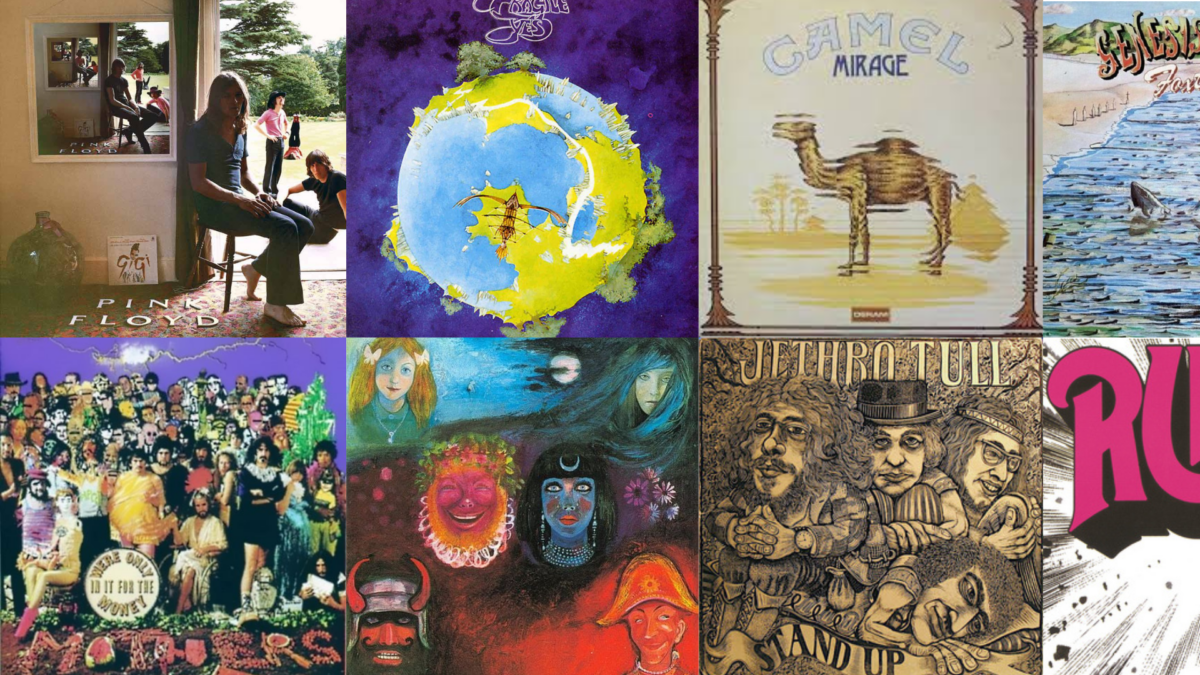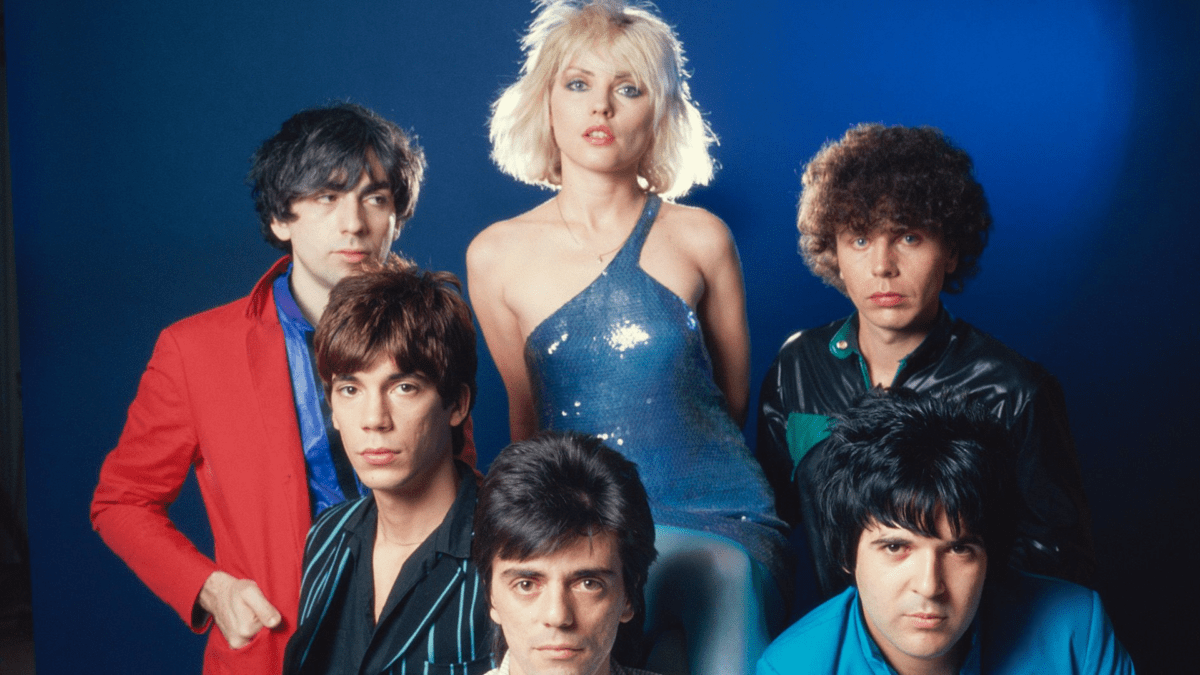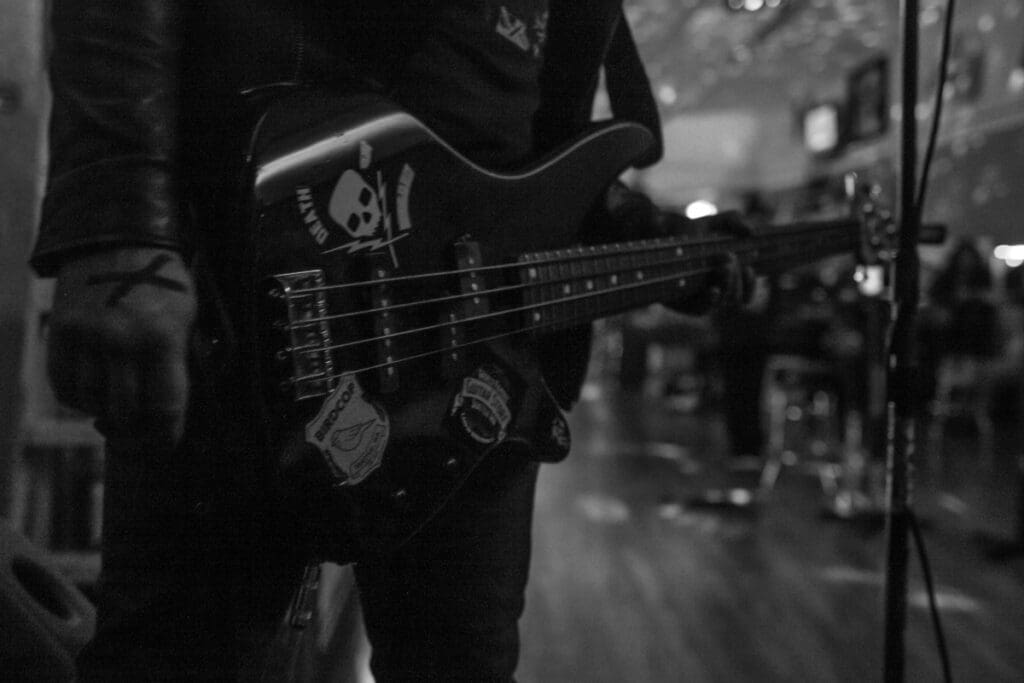
More than just a musical genre, hardcore punk is an attitude, a movement, a way of life. It’s loud, fast, aggressive, and often politically charged – a response to the mainstream, the status quo, and societal norms. It’s a sonic punch to the gut that says, “Wake up, world. We have something to say”.
Born from the seeds of traditional punk rock in the late 1970s, hardcore punk took the raw energy and rebellious spirit of its predecessor and amplified it to new levels. These were not songs for the faint of heart – they were fast, loud, and aggressive, often clocking in at less than two minutes and filled to the brim with subversive lyrics and a DIY ethos.
In this deep dive, we’ll explore the birth, evolution, and cultural impact of hardcore punk, examine its influence on other music genres, and look at its role outside the confines of music. We’ll also take a moment to highlight some notable albums that helped shape the genre. So buckle up, turn the volume up, and let’s dive headfirst into the chaotic world of hardcore punk.
The Birth of Hardcore Punk
Hardcore punk emerged in the late 70s and early 80s as an offshoot of the original punk rock movement. Bands like the Ramones and the Sex Pistols had already started to shake up the music scene with their raw, stripped-down sound and anti-establishment lyrics. However, a new wave of bands, particularly in the United States, felt that this wasn’t enough. They wanted to push the boundaries further – to be louder, faster, and more aggressive.
Cities like Los Angeles, Washington D.C., and New York became hotbeds for this new movement. Bands such as Black Flag, Bad Brains, and Minor Threat began to emerge, their sound characterised by rapid tempos, short songs, and a raw, intense energy. These bands were not interested in commercial success or radio play – they were fuelled by a desire to push back against societal norms, to challenge the status quo, and to give a voice to the disaffected youth.
The birth of hardcore punk was more than just a new music genre – it was a cultural shift. A response to a society that many felt was becoming increasingly sanitised and complacent. The establishment was being questioned, and hardcore punk was the soundtrack to this rebellion.
The Defining Characteristics of Hardcore Punk
Hardcore punk is, at its core, an amplification of traditional punk rock. It’s more aggressive sound emphasises blistering tempos, short songs, and a stripped-back, raw sound. However, there’s more to hardcore punk than just volume and speed.
One of the defining characteristics of the genre is its DIY ethos. This is a movement that was born out of a rejection of the mainstream music industry, and as such, many hardcore punk bands take a hands-on approach to their music. This means recording and producing their own music, organising their own gigs, and often releasing their own records.
Lyrically, hardcore punk is often politically charged, offering a critique of society and the status quo. There’s a raw honesty to the lyrics, a no-holds-barred approach that tackles everything from politics and society to personal struggles and experiences.
The visual aesthetic of hardcore punk is also a key component of the genre. From the stark, often provocative album art, to the band’s attire and personal style, everything is designed to make a statement, to challenge the norm, and to provoke a reaction.
The Cultural Impact of Hardcore Punk
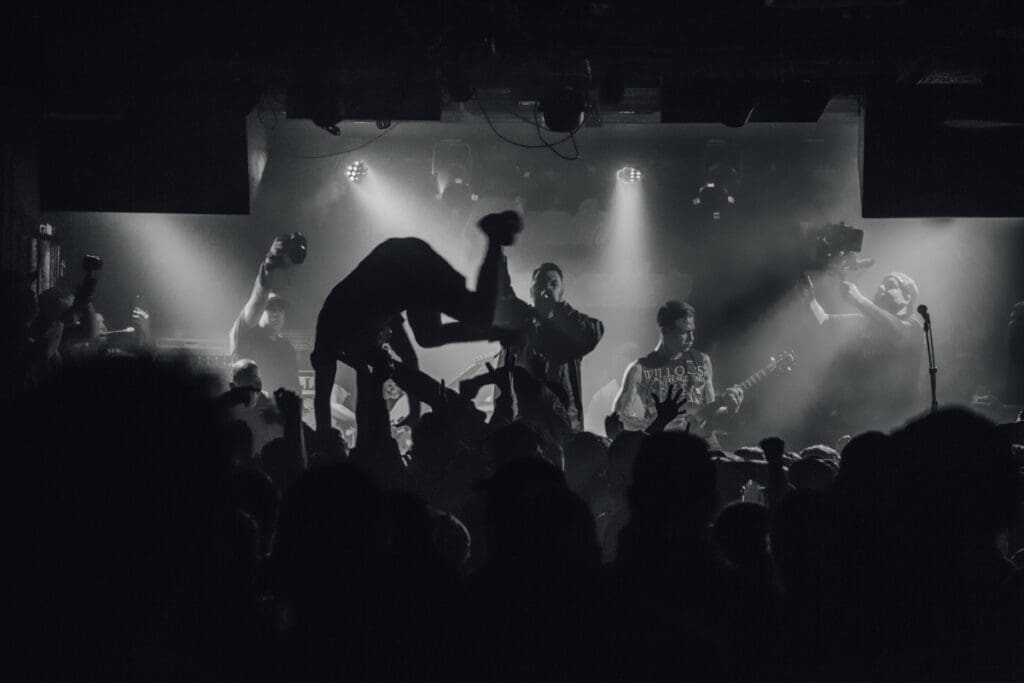
The cultural impact of hardcore punk extends far beyond the boundaries of music. It’s a movement that has influenced fashion, art, politics, and more. The DIY ethos of hardcore punk has inspired countless people to take control of their own creative output, to challenge the mainstream, and to carve out their own path.
Hardcore punk fashion is every bit as distinctive as the music itself. The look is often rough and ready, with band t-shirts, ripped jeans, and combat boots being staple items. However, it’s more than just a style – it’s a statement of identity, a visual representation of the ethos and attitude of the genre.
Politically, hardcore punk has always been a platform for social commentary and protest. The lyrics often tackle issues such as social inequality, political corruption, and personal freedom. This has, in turn, inspired many fans to become more politically aware and engaged, to question the status quo, and to fight for change.
The Influence of Hardcore Punk on Other Music Genres
Hardcore punk’s influence on other music genres is undeniable. From alternative rock and grunge to metal and indie, its fingerprints can be seen all over the musical landscape. Bands like Nirvana, Pearl Jam, and Green Day, to name just a few, have all cited hardcore punk as a major influence on their sound.
The raw energy and DIY ethos of hardcore punk have been particularly influential in the world of alternative and indie music. Many of these bands have adopted the DIY approach to making music, bypassing the traditional music industry and carving out their own path.
Many metal bands have naturally been drawn to the aggressive, raw sound of hardcore punk. This has led to the birth of crossover genres such as thrash metal and metalcore, which blend elements of hardcore punk with the heavy, distorted sound of metal.
Notable Hardcore Punk Albums
There are countless hardcore punk albums that have left their mark on the genre, but here are a few that stand out:
Black Flag – “Damaged”
“Damaged”, the debut studio album by American punk rock band Black Flag, was released on December 5, 1981, through SST Records. The album’s raw, aggressive sound and provocative lyrics provided a groundbreaking representation of the burgeoning hardcore punk scene in Southern California. Produced by Spot and Black Flag, “Damaged” showcases the band’s intense energy, with lead singer Henry Rollins’ distinctive growling vocals and the innovative guitar work of Greg Ginn, who also founded the band.
The album features 15 tracks that delve into themes of alienation, disillusionment, and frustration, reflecting the angst and rebellion that defined the punk subculture of the early 1980s. Songs like “Rise Above”, “Six Pack”, and “TV Party” have become punk anthems, inspiring a generation of musicians and fans to embrace the confrontational attitude of the genre. “Damaged” also pushed the boundaries of censorship, as its explicit content led to a legal dispute with Unicorn Records, which resulted in the album being distributed with a “Damaged” sticker on the cover.
Despite the controversy, “Damaged” has been widely acclaimed for its influence on the punk rock movement and its enduring legacy. It is often cited as one of the most important and essential punk albums of all time, and its uncompromising sound continues to resonate with fans and musicians alike, solidifying Black Flag’s place in the annals of punk history.
Discharge – “Hear Nothing See Nothing Say Nothing”
Discharge’s “Hear Nothing See Nothing Say Nothing” is a seminal album in the world of punk and hardcore. This groundbreaking work is considered a cornerstone of the D-beat subgenre, characterised by its relentless and powerful drumming style. The album’s raw energy and politically charged lyrics would resonate with listeners. Furthermore, with this release, Discharge would influence countless bands in the punk, hardcore, and metal scenes.
The themes of the album revolve around anti-war, anti-establishment, and social injustice issues, reflecting the band’s anarchist beliefs. The powerful vocals of Cal Morris, accompanied by the intense guitar work of Bones and the thundering rhythm section of Rainy and Tezz, created a unique and highly influential sound.
“Hear Nothing See Nothing Say Nothing” remains a landmark album in punk history, with its legacy still evident in various subgenres today.
Misfits – “Earth A.D./Wolfs Blood”
Misfits’ 1983 album, “Earth A.D./Wolfs Blood”, marked a significant departure from the band’s earlier horror punk sound, incorporating elements of hardcore punk and thrash metal. The album features aggressive, fast-paced songs with dark, apocalyptic themes, reflecting the growing intensity and political unrest of the punk scene during that era.
Frontman Glenn Danzig’s distinctive voice and songwriting skills are on full display in tracks like “Earth A.D.” and “Death Comes Ripping”. The album’s unpolished production adds to its overall ferocity, making it a vital work in the development of hardcore punk. Despite its relatively short runtime, “Earth A.D./Wolfs Blood” packs a powerful punch with its relentless energy and uncompromising attitude.
Over time, the album has gained a cult following and is considered a classic within the punk rock community. Its influence can be heard in the music of numerous bands that followed, such as Metallica. The San Francisco thrash metal innovators covered “Green Hell” and “Die, Die My Darling” in their 1987 EP “The $5.98 E.P. – Garage Days Re-Revisited”. Misfits’ “Earth A.D./Wolfs Blood” remains an essential listen for any fan of punk rock and a testament to the band’s enduring impact on the genre.
Cro-Mags – “The Age of Quarrel”
“The Age of Quarrel” was the first full-length studio album by the New York-based Cro-Mags. The album’s raw energy, aggressive lyrics, and powerful performances catapulted the band to the forefront of the hardcore punk scene, establishing them as one of its most influential acts.
“The Age of Quarrel” is often regarded as a cornerstone of the crossover thrash genre, combining elements of hardcore punk and thrash metal in a unique and compelling way. Its tracks tackle hard-hitting topics like urban decay, social disarray, and personal struggle, reflecting the gritty reality of life in New York City during that era. The album’s musical style is characterised by fast-paced rhythms, heavy guitar riffs, and intense vocals, which together create a sound that is both raw and powerful.
“The Age of Quarrel” remains a highly respected release in the world of hardcore punk. Its influence can be heard in the music of many subsequent bands, reinforcing its status as a timeless classic. For hardcore veterans and newcomers alike, this album offers a compelling exploration of the genre’s defining intensity and passion.
Bad Brains – “I Against I”
The album “I Against I” by the American rock band Bad Brains marked a turning point in the history of punk rock. Released in 1986, this album deviates from the band’s earlier hardcore punk style, incorporating elements of funk, soul, and heavy metal to create a unique sound that defies genre boundaries. The title track reflects the band’s exploration of inner conflict and the struggle for self-identity, a theme that resonates throughout the album.
The intricate fusion of styles in “I Against I” demonstrates Bad Brains’ versatility and musical prowess while enabling them to push the boundaries of punk rock. The album’s lyrics tackle socio-political issues, providing a powerful commentary on the world around them. Despite its release over three decades ago, “I Against I” continues to influence and inspire musicians today, attesting to its timeless relevance.
In essence, Bad Brains’ “I Against I” is more than just an album. It’s a testament to the band’s innovation, creativity, and their ability to redefine musical norms. It remains a landmark record in the punk rock genre and serves as a significant influence on contemporary music.
Converge – “Jane Doe”
“Jane Doe” is the fourth studio album by American metalcore band Converge, released in 2001 through Equal Vision Records. The album marked a significant shift in the band’s sound, blending aggressive hardcore punk with chaotic and experimental metal elements. This innovative approach established “Jane Doe” as a landmark album in the metalcore genre, with its complex song structures, raw emotion, and powerful instrumentation.
The album features Jacob Bannon’s distinctive vocal style, ranging from guttural screams to anguished cries, which convey the album’s themes of heartbreak, loss, and personal struggle. Kurt Ballou’s intricate guitar work and Ben Koller’s relentless drumming create an intense and dynamic sonic landscape, while Nate Newton’s bass lines provide a solid foundation. The 12 tracks on “Jane Doe” showcase the band’s technical prowess and emotional depth. Standout songs include “Concubine”, “Fault and Fracture”, and the epic title track.
“Jane Doe” received widespread critical acclaim for its innovative and genre-defining sound, and it has since become a cult classic among fans of heavy music. The album’s influence exists in the work of countless bands that followed. As a result, it remains a touchstone in the metalcore and hardcore punk scenes.
Gallows – “Grey Britain”
“Grey Britain” by Gallows is an unapologetic reflection of the social and political turmoil that the UK was facing at the time of its release in 2009. This album showcases a more mature and thematically focused approach to songwriting than their previous efforts.
Instead of relying on generic themes, “Grey Britain” addresses issues such as economic disparity, disillusionment with the political system, and the general sense of despair felt by many young people in Britain. The album’s confrontational lyrics and aggressive musical style serve to amplify its potent social commentary.
“Grey Britain” received mixed reviews upon its release. However, its uncompromising vision and raw energy have earned it a place in the annals of UK punk history. Today, it’s an important statement about a particularly turbulent period in modern British society.
Gallows’ “Grey Britain” is a snapshot of a time and place, capturing the anger and frustration of a generation. Its enduring relevance is a testament to the power of music as a medium for social commentary.
Code Orange – “Underneath”
Code Orange’s “Underneath” is a groundbreaking album that showcases the band’s ability to push boundaries and defy genre limitations. The album is a sonic exploration, powerfully blending elements of hardcore, metal, industrial, and electronic music.
The 14-track record features a mix of aggressive riffs, guttural vocals, and haunting melodies that captivate the listener. Standout tracks such as “Swallowing the Rabbit Whole”, “In Fear”, and “Cold.Metal.Place” highlight the band’s innovative and dynamic songwriting. The lyrics delve into themes of personal struggle, self-discovery, and the darker aspects of human nature. As a result, the album makes for an intense and introspective listening experience.
“Underneath” has been met with critical acclaim, with many praising its experimental nature and the band’s willingness to take risks. The album is a testament to Code Orange’s growth as artists, as they continue to challenge the status quo and redefine the boundaries of heavy music. It is a must-listen for fans of hardcore punk, metal, and those seeking a fresh and innovative sound in the music scene.
Kvelertak – “Kvelertak”
Kvelertak’s 2010 debut is a compelling testament to the band’s unique sound and musical prowess. It showcases the Norwegian band’s raw energy and innovative blend of various rock sub-genres. The album, sung entirely in Norwegian, delivers a potent mixture of black metal, punk rock, and classic rock and roll.
“Kvelertak”, translating to “stranglehold” or “chokehold” in English, encapsulates the band’s aggressive sound with its heavy guitar riffs, guttural vocals, and relentless drumming. Despite the language barrier for non-Norwegian speakers, the band’s passion and musicality shine through, making it a universal hit among rock fans worldwide.
The album contains an interesting array of songs that effectively highlight Kvelertak’s versatility. Ranging from fast-paced and high-energy to slower and melodic, they demonstrate Kvelertak’s ability to create diverse soundscapes within their genre.
The critical success of “Kvelertak” firmly established the band in the international rock scene. It not only won them numerous music awards in Norway but also paved the way for their successive albums. Accordingly, the album is a significant piece of work that represents Kvelertak’s distinctive style and underlines their contribution to modern rock music.
Refused – “The Shape of Punk to Come”
Refused’s groundbreaking 1998 album, “The Shape of Punk to Come”, is a seminal work that redefined the punk genre and established the band as a force to reckon with. Merging elements of hardcore punk, metal, and experimental rock, the Swedish group created a sound that was both innovative and influential. The album’s title, a nod to Ornette Coleman’s “The Shape of Jazz to Come”, suggests the band’s ambition to revolutionise the punk scene.
Produced by Pelle Henricsson and Eskil Lövström, the album features aggressive and powerful tracks like “New Noise” and “Refused Party Program”. These standout efforts showcase the band’s ability to combine raw energy with complex song structures. The lyrics tackle political and social issues, reflecting the band’s anarchist and anti-capitalist stance. “The Shape of Punk to Come” also incorporates elements of electronic music and jazz, adding sophistication to the punk sound.
Despite initially receiving mixed reviews, the album has since become a cult classic and a touchstone for modern punk and hardcore bands. Its impact is evident in the works of bands like At the Drive-In, Converge, and Glassjaw, proving that Refused’s vision of the future of punk was indeed prophetic. As a result, the album’s legacy continues to inspire new generations of musicians, solidifying its status as an essential piece of punk history.
Gorilla Biscuits – “Start Today”
The 1989 album “Start Today” by Gorilla Biscuits is a pivotal piece in the realm of hardcore punk. It represented a significant evolution in the genre, offering a breath of fresh air with its blend of aggression and melody. Moreover, the album is notable for its powerful lyrics, which address societal issues and personal struggles with an honesty rarely seen in the music scene at the time.
The band’s approach to composition was groundbreaking, with intricate guitar riffs and pulsating drum lines that diverged from the traditional hardcore sound. Furthermore, each track on “Start Today” emphasises a distinct energy and intensity, echoing the band’s live performances.
The album played a key role in shaping the New York hardcore scene and has since influenced countless bands worldwide. Despite its age, “Start Today” remains a quintessential listen, perfectly embodying the spirit and ethos of hardcore punk. It stands as a testament to Gorilla Biscuits’ musical prowess and their enduring impact on punk culture.
The Evolution of Hardcore Punk: From Origins to Present
Hardcore punk has evolved significantly since its birth in the late 70s and early 80s. While the core elements of the genre – the raw nature, the DIY ethos, the political commentary – remain, the sound has evolved and expanded, incorporating influences from other genres and reflecting the changing times.
In the late 80s and early 90s, we saw the rise of post-hardcore and emo. These genres took the raw sound and emotional intensity of hardcore punk and combined it with more melodic, complex song structures. Bands like Fugazi and Rites of Spring were at the forefront of this movement, pushing the boundaries of what hardcore punk could be.
In the 2000s and beyond, hardcore punk has continued to evolve and diversify. Modern genres like metalcore and hardcore revival blend elements of hardcore punk with metal and indie rock. Bands like Converge and Touche Amore have helped to push the genre in new, exciting directions.
Conclusion: The Legacy of Hardcore Punk
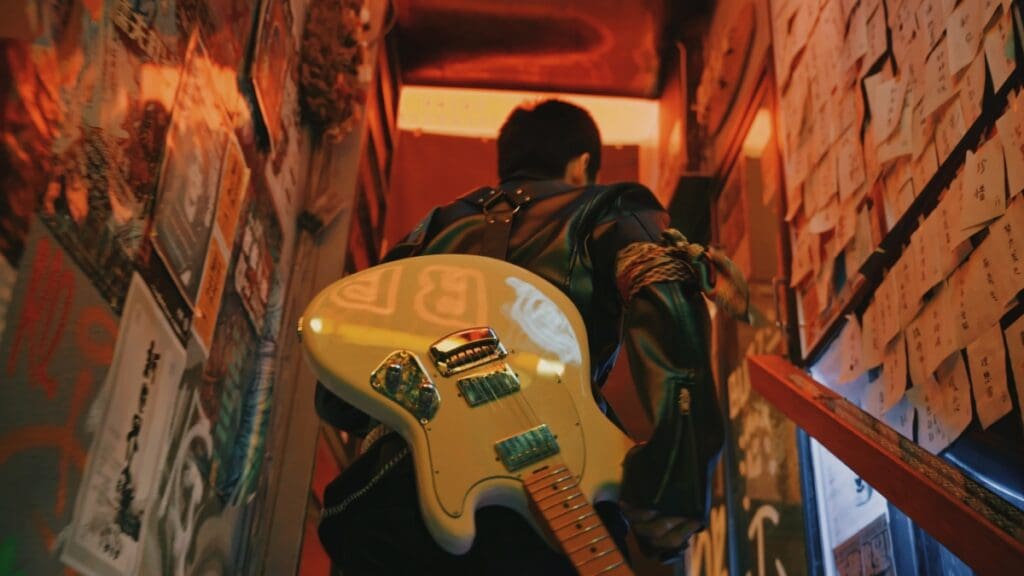
From its birth in the late 70s to its influence on other genres, hardcore punk has left an indelible mark on music. Its raw sound, DIY ethos, and political commentary have resonated with countless musicians and fans, inspiring a whole new generation of artists to push the boundaries and challenge the status quo.
The legacy of hardcore punk is one of rebellion and resistance, of questioning the norm and fighting for change. It’s a genre that refuses to be tamed, to be boxed in, to be anything other than itself. And in a world that often seems too complacent, too willing to follow the path of least resistance, this is a legacy worth celebrating.






